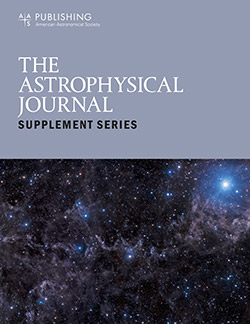光蒸发和近距离接触:天鹅座OB2周围的环境如何影响原行星盘的演化
IF 8.6
1区 物理与天体物理
Q1 ASTRONOMY & ASTROPHYSICS
引用次数: 26
摘要
在我们的银河系中,恒星形成发生在各种环境中,其中很大一部分恒星形成于拥有大质量恒星的星团中。OB恒星对围绕附近年轻恒星运行的原行星盘的演化以及可能发生在其中的行星形成过程具有重要的反馈。附近的大质量星系Cyg OB2是研究这种反馈的杰出实验室。它是离太阳最近的大质量星系,拥有数百颗大质量恒星和数千颗低质量恒星,有或没有圆盘。本文分析了Cyg OB2中盘分数(即带有盘的星团成员的分数)的空间变化,并研究了其与局域远紫外(FUV)和极紫外(EUV)辐射场值以及局域恒星表面密度的相关性。我们提供了明确的证据表明,在以强烈的局部紫外场和大恒星密度为特征的联合区域,盘的消散速度更快。特别是,在O星附近(即0.5个百分点以内),FUV辐射支配着盘的耗散时间尺度。在星系团的其余部分,EUV光子可能会从整个星系团的辐射盘中引起显著的质量损失,但随着与大质量恒星距离的增加,由于中间的星系团内物质的吸收,这一过程的效率会降低。我们发现,在Cyg OB2中,由于恒星的近距离接触而导致的磁盘耗散可以忽略不计,可能只影响了1%或更少的恒星群。相反,磁盘耗散主要由光蒸发控制。我们还将我们的结果与在其他具有不同大质量人口的年轻星团中发现的结果进行了比较,得出的结论是,像Cyg OB2这样的大质量星团可能对原行星盘不利,但行星系统中磁盘可以安全地进化的环境可能在我们的银河系中相当普遍。本文章由计算机程序翻译,如有差异,请以英文原文为准。
Photoevaporation and Close Encounters: How the Environment around Cygnus OB2 Affects the Evolution of Protoplanetary Disks
Abstract In our Galaxy, star formation occurs in a variety of environments, with a large fraction of stars formed in clusters hosting massive stars. OB stars have an important feedback on the evolution of protoplanetary disks orbiting around nearby young stars and likely on the process of planet formation occurring in them. The nearby massive association Cyg OB2 is an outstanding laboratory to study this feedback. It is the closest massive association to our Sun and hosts hundreds of massive stars and thousands of low-mass members, both with and without disks. In this paper, we analyze the spatial variation of the disk fraction (i.e., the fraction of cluster members bearing a disk) in Cyg OB2 and study its correlation with the local values of far-ultraviolet (FUV) and extreme-ultraviolet (EUV) radiation fields and the local stellar surface density. We present definitive evidence that disks are more rapidly dissipated in the regions of the association characterized by intense local UV fields and large stellar density. In particular, the FUV radiation dominates disk dissipation timescales in the proximity (i.e., within 0.5 pc) of the O stars. In the rest of the association, EUV photons potentially induce a significant mass loss from the irradiated disks across the entire association, but the efficiency of this process is reduced at increasing distances from the massive stars owing to absorption by the intervening intracluster material. We find that disk dissipation due to close stellar encounters is negligible in Cyg OB2 and likely to have affected 1% or fewer of the stellar population. Disk dissipation is instead dominated by photoevaporation. We also compare our results to what has been found in other young clusters with different massive populations, concluding that massive associations like Cyg OB2 are potentially hostile to protoplanetary disks but that the environments where disks can safely evolve in planetary systems are likely quite common in our Galaxy.
求助全文
通过发布文献求助,成功后即可免费获取论文全文。
去求助
来源期刊

Astrophysical Journal Supplement Series
地学天文-天文与天体物理
CiteScore
14.50
自引率
5.70%
发文量
264
审稿时长
2 months
期刊介绍:
The Astrophysical Journal Supplement (ApJS) serves as an open-access journal that publishes significant articles featuring extensive data or calculations in the field of astrophysics. It also facilitates Special Issues, presenting thematically related papers simultaneously in a single volume.
 求助内容:
求助内容: 应助结果提醒方式:
应助结果提醒方式:


